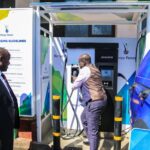
Researchers from the National University of Singapore (NUS) and Tohoku University (TU) in Japan have discovered a method of harnessing wireless signals and converting them into energy that can be used to power small electronics.
The new method which will require the use of spin-torque oscillators will harvest and in turn convert wireless radio frequencies and this would be used for small electronics.
In the new study, energy from Wi-Fi-band signals was successfully extracted to power a light-emitting diode (LED) wirelessly without the use of a battery in a ground breaking research.
The research breakthrough was achieved by a team led by Professor Yang Hyunsoo (left). Dr. Raghav Sharma (right), the first author of the paper, is holding a chip embedded with about 50 spin-torque oscillators. Credit: National University of Singapore
The result of the research which was published in Nature Communications had collaboration between the research team of Professor Guo Yong Xin, from the Department of Electrical and Computer Engineering, National University of Singapore (NUS), together with Tohoku’s University (TU) Professor, Shunsuke Fukami, and his team.
A visibly elated Professor Yang Hyunsoo from the National University of Singapore Department of Electrical and Computer Engineering who also spearheaded the project had this to say:
“We are surrounded by Wi-Fi signals, but when we are not using them to access the Internet, they are inactive, and this is a huge waste. Our latest result is a step towards turning readily available 2.4GHz radio waves into a green source of energy, hence reducing the need for batteries to power electronics that we use regularly. In this way, small electric gadgets and sensors can be powered wirelessly by using radiofrequency waves as part of the Internet of Things. With the advent of smart homes and cities, our work could give rise to energy-efficient applications in communication, computing, and neuromorphic systems,”
This discovery may yet signal the birth of a new dawn as a large chunk of Wi-Fi energy hare left untapped and the bulk of that energy can be used to power bigger devices in the soon future with more discoveries.
The digital age has recorded the growth of Wi-Fi sources which has transmitted information seamlessly between devices, resulting in the continuous use of the 2.4GHz radio frequency that has come to be associated with the wireless technology, with the availability of excess signals for alternative uses.
The Process
Let’s look at what Spin-torque oscillators are.
Spin-torque oscillators are devices based on the spin-transfer torque (STT) effect in the magnetic multilayered nanostructure that generate microwaves with applications in the wireless communication system.
The researchers took cognizance of the fact that STOs application is hindered due to a low output power and broad line width, they had to make do with synchronization of multiple STOs in a form of short-range magnetic coupling. It surely does have inhibitions by spatial and low-frequency limitations; the team thus came with an idea of having eight STOs connected in series. In the synchronization, the 2.4 GHz electromagnetic waves from Wi-Fi was converted into a direct voltage signal and then transmitted to a capacitor which will in turn light up a 1.6 volt LED. The capacitor is charged for 5 seconds can then power the same LED after the wireless power has been disconnected.
According to the researchers, electrical topology is important for designing on-chip STO systems and thus connections that existed with the different components are made sure to be stable. It was discovered that the parallel configuration method is better suited for wireless transmission than series connection because of its stable time -domain, spectral noise behaviour and impedance mismatch control. The series connection may has the advantage of energy harvesting as a result of the additive effect of the diode-voltage emanating from the STOs, but the parallel configuration is better suited.
The first author of the paper, Dr. Raghav Sharma while analysing the significance of the research results posited: “Aside from coming up with an STO array for wireless transmission and energy harvesting, our work also demonstrated control over the synchronizing state of coupled STOs using injection locking from an external radio-frequency source. These results are important for prospective applications of synchronized STOs, such as fast-speed neuromorphic computing.”
Probable Moves
The new technology requires more energy harvesting ability; the teams of researchers are of the view that the number of STOs in the array designed has to be increased to achieve this. They also want to look to see if their energy harvesters can be wirelessly charged to see if they can be useful for other sensors and electronic devices.
According to the Professor Yang Hyunsoo led research team, they are also seeking ways to liaise with industry partners to explore the possibility of developing on-chip STOs that would be suitable for self-sustained smart systems and this will in turn pave way for wireless charging and wireless signal detection systems.
It is not yet Uhuru but a bridge has definitely been crossed!
Kudos to the team of researchers from the National University of Singapore and Tohoku University, Japan.
Discover more from TechBooky
Subscribe to get the latest posts sent to your email.







